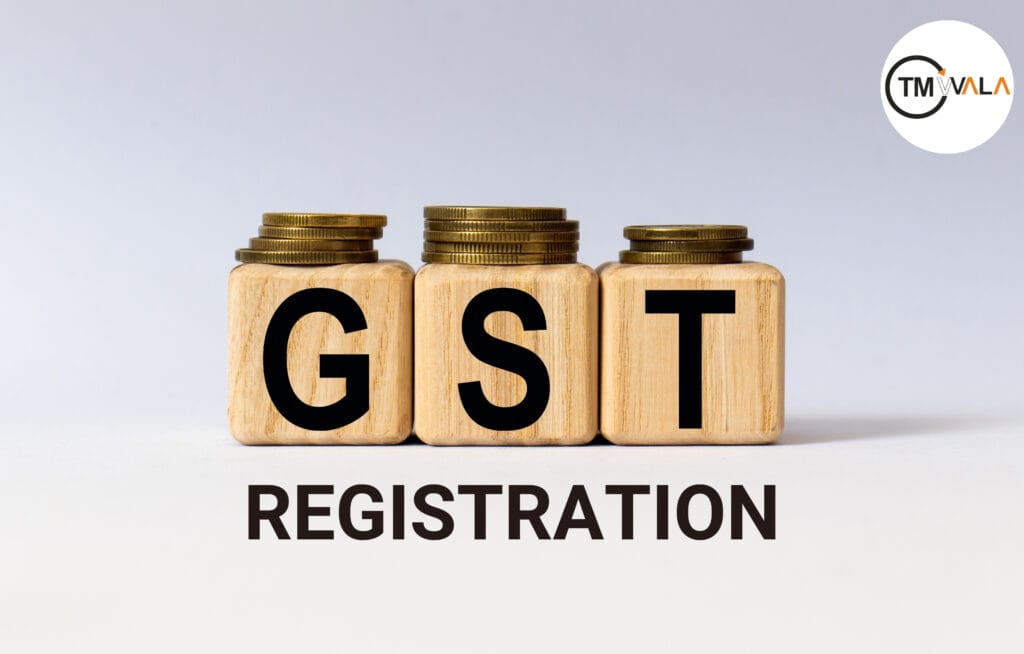Introduction
Goods and Services Tax (GST) is a comprehensive indirect tax introduced in 2016, levied on the supply of goods and services at each stage of the production and distribution chain. GST replaced various indirect taxes such as VAT and Service tax, aiming to create a unified and simplified taxation system, reduce tax evasion, and promote an efficient and transparent tax structure. Businesses under GST charge and collect GST on sales and claim credits for the GST paid on purchases. GST is a destination-based tax, meaning the end consumer ultimately bears the tax.
What is GST Registration?
GST registration is the process by which a taxpayer registers under GST. Upon successful registration, a business is assigned a unique 15-digit Goods and Services Tax Identification Number (GSTIN) by the central government. This number is essential for the identification of the business for tax purposes and compliance verification.
Businesses with a turnover exceeding ₹40 lakh ₹ 20 lakh, or ₹ 10 lakh, depending on the state, must register as a normal taxable person. Certain businesses must register under GST, and failure to do so is an offence, resulting in heavy penalties. The GST registration process typically takes between 2-6 working days.
Importance of GST Registration
Registration under the GST regime provides several advantages to a business:
- Legal recognition as a supplier of goods or services.
- Proper accounting of taxes paid on input goods or services, which can be utilized for payment of GST due on the supply of goods or services.
- The ability to pass on the credit of taxes paid on supplied goods or services to purchasers or recipients.
- Authorization to collect tax on behalf of the Government.
Types of GST Registration
There are various types of GST Registration under the GST Act, 2017:
- Normal Taxpayer: For most businesses in India. No deposit required and no expiry date.
- Casual Taxable Person: For individuals setting up a seasonal shop or stall. An advance deposit equal to the expected GST liability is required. The duration is 3 months, extendable or renewable.
- Composition Taxpayer: For businesses opting for the GST Composition Scheme. A flat rate is deposited, and the input tax credit cannot be claimed.
- Non-Resident Taxable Person: For foreign businesses supplying goods to individuals in India. An advance deposit equal to the expected GST liability is required. The duration is 3 months, extendable or renewable.
- Input Service Distributor (ISD) Registration: For businesses distributing input tax credit to different branches having the same PAN.
- TDS (Tax Deducted at Source) and TCS (Tax Collected at Source) Registration: For entities required to deduct tax at source or collect tax at source under GST provisions.
- E-commerce Operator Registration: Mandatory for operators facilitating online sales through their platform.
- URD (Unregistered Dealer): Dealers not registered under GST but involved in taxable supply; generally required to register if they exceed the threshold limit.
Eligibility for GST Registration
GST Registration must be completed by the following individuals and businesses:
- Individuals registered under the tax services before GST law.
- Non-Resident Taxable Person.
- Casual Taxable Person.
- Individuals paying tax under the reverse charge mechanism.
- All e-commerce aggregators.
- Businesses with a turnover exceeding ₹ 40 lakh (₹ 10 lakh for certain states).
- Input service distributors and agents of a supplier.
- Individuals supplying goods through an e-commerce aggregator.
- Individuals providing database access and online information from outside India to people in India, excluding registered taxable persons.
- Businesses with an annual turnover of ₹ 20 lakh and more.
- Entities liable to deduct TDS or collect TCS.
- Taxpayers making interstate supplies.
- Individuals making casual supplies of taxable goods or services.
- Agents making supplies on behalf of other registered taxpayers.
- New owners in case of a proprietor’s death or business transfer/merger.
- Non-resident taxable suppliers of goods/services.
- E-commerce portal operators and suppliers.
- UN bodies, embassies, and other notified bodies, including government bodies.
Documents Required for GST Registration
1. Sole Proprietor / Individual
- PAN card of the owner
- Aadhaar card of the owner
- Photograph of the owner (in JPEG format, maximum size – 100 KB)
- Bank account details
- Address proof
2. Partnership Firm / LLP
- PAN card of all partners (including managing partner and authorized signatory)
- Copy of partnership deed
- Photograph of all partners and authorized signatories (in JPEG format, maximum size – 100 KB)
- Address proof of partners (Passport, driving license, Voter’s identity card, Aadhaar card, etc.)
- Aadhaar card of authorized signatory
- Proof of appointment of authorized signatory
- In the case of LLP, registration certificate / Board resolution of LLP
- Bank account details
- Address proof of principal place of business
- Hindu Undivided Family (HUF)
- PAN card of HUF
- PAN card and Aadhaar card of Karta
- Photograph of the owner (in JPEG format, maximum size – 100 KB)
- Bank account details
- Address proof of principal place of business
- Company (Public / Private / Indian / Foreign)
- PAN card of the company
- Certificate of incorporation issued by the Ministry of Corporate Affairs
- Memorandum of Association / Articles of Association
- PAN card and Aadhaar card of the authorized signatory. The authorized signatory must be an Indian even in the case of foreign companies/branch registration
- PAN card and address proof of all directors of the company
- Photograph of all directors and authorized signatory (in JPEG format, maximum size – 100 KB)
- Board resolution appointing authorized signatory / Any other proof of appointment of authorized signatory (in JPEG format / PDF format, maximum size – 100 KB)
- Bank account details
- Address proof of principal place of business
(Notes: a. Bank account details: This includes the first page of the passbook, bank statement, or a cancelled cheque.b. Address proof: Acceptable documents include an electricity bill, property tax receipt, rent agreement, legal ownership document, municipal khata copy, etc.)
Detailed Step-by-Step Guide for GST Registration
Part A: Initial Registration
- Visit GST Portal:
- Navigate to the official GST portal: https://www.gst.gov.in/.
- Access New Registration:
- On the homepage, go to Services > Registration > New Registration.
- Fill in Required Details:
- In the “I am a” dropdown, select the type of taxpayer you are registering as, such as Taxpayer, Tax Deductor, Tax Collector, etc.
- Fill in the following details:
- State/UT: Select the state or union territory of the business.
- District: Select the district of the business.
- Legal Name of the Business: Enter the name exactly as it appears on the PAN card.
- Permanent Account Number (PAN): Enter the PAN of the business or proprietor.
- Email Address: Provide a valid email address.
- Mobile Number: Provide a valid mobile number.
- OTP Verification:
- After filling in the details, click on Proceed.
- An OTP will be sent to the provided email address and mobile number. Enter both OTPs in the respective fields.
- Temporary Reference Number (TRN):
- After successful OTP verification, a 15-digit TRN will be generated and displayed on the screen. This TRN will also be sent to the registered email and mobile number.
- Login Using TRN:
- Go back to the GST portal homepage, select Services > Registration > New Registration.
- Select Temporary Reference Number (TRN).
- Enter the TRN and Captcha code, then click Proceed.
- Verify the OTP sent to the registered email and mobile number.
Part B: Completion of Application
- Access Saved Application:
- After OTP verification, the dashboard will display saved applications. Click on the Edit icon to start filling in the remaining details.
- Fill in Business Details:
- Trade Name: Enter the trade name of the business, if different from the legal name.
- Constitution of Business: Select the appropriate type of business entity, such as proprietorship, partnership, company, etc.
- District
- Sector/Circle/Ward/Charge/Unit: Provide details as required.
- Centre Jurisdiction: For this section, a link is provided on the same page, which allows you to fill in the following fields – Commissionerate Code, Division Code, and Range Code.
- Are you applying for registration as a casual taxable person?: Select “No”, if you are a regular dealer.
- Option for Composition: Select “No”, if you are a regular dealer.
- Date of Commencement of Business: Enter the date when the business commenced.
- Date on which liability to register arises: Enter the date from which GST liability arises.
- Reason to obtain registration: Select the reason for obtaining GST registration.
- Promoter/Partners Details:
- Add details of promoters/partners, including:
- Personal Information: Name, name of father, date of birth, address, mobile number, email address, gender, and telephone no.
- Identity Information: Designation, DIN, PAN and Aadhaar number.
- Photograph: Upload a photograph (JPEG format, maximum size 100 KB) or take a selfie photograph with the device’s camera.
- Repeat for all promoters/partners.
- Add details of promoters/partners, including:
- Authorized Signatory Details:
- Provide details of the primary authorized signatory, including personal and identity information.
- Upload a photograph and provide digital signature details.
- Authorized Representative Details: Yes/No; if you select “No,” the page will remain unchanged; if you select “Yes,” additional fields will appear, fill in the details.
- Principal Place of Business:
- Enter the address of the principal place of business.
- Upload proof of principal place of business (e.g., electricity bill, rent agreement).
- Provide contact details and nature of possession of premises and business activity.
- Additional Places of Business:
- If applicable, enter details of additional places of business.
- Goods and Services:
- Specify the top five goods and services supplied by the business along with HSN/SAC codes.
- Bank Account Details:
- Provide details of the bank account, including account number, type of account, and IFSC code.
- Upload proof of bank account (e.g., first page of passbook, bank statement, cancelled cheque).
- State Specific Information:
- Fill in any additional information required by the respective state.
- Verification:
- Verify the application using the authorized signatory’s digital signature (DSC), E-Sign, or EVC.
- For Digital Signature Certificate (DSC), ensure the DSC is registered on the GST portal.
- Submit Application:
- Once all sections are completed and verified, submit the application.
- A success message will be displayed, and an Application Reference Number (ARN) will be generated and sent to the registered email and mobile number.
Post-Submission:
- Verification by Tax Authorities:
- The application and documents will be verified by the GST authorities.
- If any additional information or documents are required, the applicant will be informed.
- Issuance of GSTIN:
- Upon successful verification, the GSTIN and GST registration certificate will be issued.
- The certificate can be downloaded from the GST portal.
Note:
- The status of the application can be tracked using the ARN on the GST portal.
- Ensure all details are accurately filled and documents are properly uploaded to avoid any delays or rejections.
Exemption from GST Registration
Certain individuals and entities are exempt from GST registration:
- Businesses making supplies eligible for reverse charge mechanism.
- Activities not categorized as supply of goods or services, such as sale of land, funeral services, and employee services.
- Entities making non-GST/non-taxable supplies like electricity, natural gas, and petrol.
- Businesses engaged in exempt or nil-rated supplies.
- Those falling under the threshold exemption limit of ₹ 20 lakh (₹ 10 lakh for special category states).
- Agriculturists engaged in agricultural activities are also exempt from GST registration requirements.
Features of GST Registration
GST registration entails several key features:
- PAN-based and State-specific: GST registration is based on the Permanent Account Number (PAN) and is specific to each state or union territory where the business operates or supplies goods/services.
- Unified Taxation System: GST integrates various indirect taxes into a single platform, streamlining tax administration and compliance across the country.
- Threshold-based Registration: Businesses with an annual turnover above the specified threshold (₹ 20 lakh, ₹ 10 lakh for special category states) are required to register for GST, ensuring broader tax coverage.
- Multiple Registration Types: GST offers various registration types tailored to different business needs, including regular taxpayer, composition scheme, casual taxable person, and others.
- Input Tax Credit (ITC): Registered businesses can claim ITC on taxes paid on inputs, facilitating cost reduction and encouraging compliance within the supply chain.
- Legal Recognition and Compliance: GST registration legally recognizes businesses as suppliers of goods/services, obligating them to comply with GST regulations, including filing returns and maintaining proper records.
- Interstate Operations: Businesses operating in multiple states must obtain separate GST registrations for each state, ensuring compliance with state-specific tax laws and facilitating interstate trade seamlessly.
Benefits of GST Registration
1. Elimination of Cascading Tax Effect: GST eliminates the cascading effect of tax, where tax on tax increases the cost of goods and services, thus reducing the overall price.
2. Transparency: GST promotes transparency in taxation, eliminating hidden charges and reducing business expenses.
3. Input Tax Credit and Reduced Tax Evasion: Input tax credit encourages compliance by allowing credit for taxes paid on inputs used in business, thereby reducing tax evasion.
4. Composition Schemes for Small Businesses: Small businesses benefit from reduced tax and compliance burdens under composition schemes, applicable for turnover between ₹ 20 lakh to ₹ 75 lakh.
5. Higher Registration Threshold: GST raises the threshold for mandatory registration to ₹ 20 lakh, exempting many small businesses and service providers.
6. Unified Compliance: GST simplifies compliance with a unified return filing system, replacing multiple tax returns required under previous tax laws.
7. Defined Treatment for E-commerce: GST provides clear guidelines for online merchants, eliminating disparities in tax treatment across states and sectors.
8. Regulation of Unorganized Sectors: Industries like textiles and construction, previously unorganized, benefit from GST’s online compliance and payment mechanisms, ensuring accountability.
9. Improved Logistics Efficiency: GST enhances logistics efficiency by facilitating smoother movement of goods across state borders, encouraging centralized warehouse locations in major cities.
These features and benefits underscore GST’s role in simplifying taxation, promoting transparency, and streamlining business operations across India.
Conclusion
In conclusion, GST registration is a pivotal requirement for businesses in India, ensuring compliance with the unified taxation system aimed at simplifying processes, eliminating tax cascading, and fostering transparency. It empowers businesses to participate in the formal economy, claim input tax credits, and contribute to the nation’s economic growth by facilitating smoother interstate and international trade. Embracing GST registration not only enhances operational credibility but also aligns businesses with contemporary tax practices, fostering a conducive environment for sustainable growth and development.
FAQs
Who needs to register for GST?
Any business or individual whose turnover exceeds the threshold limit of ₹ 20 lakh (₹ 10 lakh for special category states) in a financial year must register for GST. Certain businesses are also mandated to register irrespective of turnover.
What is the threshold limit for GST registration?
The threshold limit for GST registration is ₹ 20 lakh of annual turnover for most states in India. However, it is ₹ 10 lakh for special category states like Uttarakhand, Himachal Pradesh, Jammu & Kashmir, and Northeastern states.
Can I voluntarily register for GST even if my turnover is below the threshold limit?
Yes, voluntary registration for GST is allowed even if your turnover does not exceed the threshold limit. This can be beneficial for businesses looking to claim input tax credit or those conducting interstate transactions.
What are the different types of GST registration?
GST registration types include Regular Taxpayer, Composition Scheme, Casual Taxable Person, Non-Resident Taxable Person, Input Service Distributor, TDS/TCS Deductor, E-commerce Operator, and Unregistered Dealer.
How do I apply for GST registration?
You can apply for GST registration online through the GST portal (www.gst.gov.in) by filling out the GST REG-01 form and providing necessary documents as per your business type.
What documents are required for GST registration?
Commonly required documents include PAN card, Aadhaar card, proof of business registration, identity/address proofs of promoters/partners/directors, photographs, bank account details, and proof of principal place of business.
What is the process for GST registration?
GST registration involves two parts: Part A and Part B. In Part A, you obtain a Temporary Reference Number (TRN) by submitting basic details. In Part B, you complete the application with detailed business information and upload supporting documents.
How long does it take to get GST registration?
GST registration typically takes between 2 to 6 working days from the date of submission of the application, provided all documents and information are in order.
What are the benefits of GST registration?
Benefits include eligibility to collect GST from customers, claim input tax credit, participate in interstate and international trade, avail composition scheme for lower compliance, and enhance business credibility.
Do I need separate GST registrations for different states?
Yes, businesses operating in multiple states or union territories must obtain separate GST registrations for each state/UT where they have operations or supply goods/services.
Is GST registration mandatory for e-commerce sellers?
Yes, e-commerce operators are required to register for GST, irrespective of turnover, and collect tax at source (TCS) on behalf of suppliers selling through their platform.
What happens if I do not register for GST despite being liable?
Operating without GST registration when liable to register is an offense under GST law. It can lead to penalties and legal consequences, including interest on unpaid tax liabilities.
Can I cancel my GST registration?
Yes, GST registration can be canceled voluntarily if the business ceases operations or no longer meets the threshold requirements. It can also be canceled by tax authorities for non-compliance or other reasons.
What is the validity period of GST registration?
GST registration does not have a fixed validity period. It remains valid as long as the business continues to operate and comply with GST regulations. However, periodic renewal of information may be required.
Can I modify or update my GST registration details?
Yes, registered persons can update their GST registration details such as business address, bank account details, authorized signatory, etc., online through the GST portal using the amendment application form.















